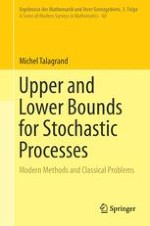2014 | Buch
Upper and Lower Bounds for Stochastic Processes
Modern Methods and Classical Problems
verfasst von: Michel Talagrand
Verlag: Springer Berlin Heidelberg
Buchreihe : Ergebnisse der Mathematik und ihrer Grenzgebiete. 3. Folge / A Series of Modern Surveys in Mathematics
